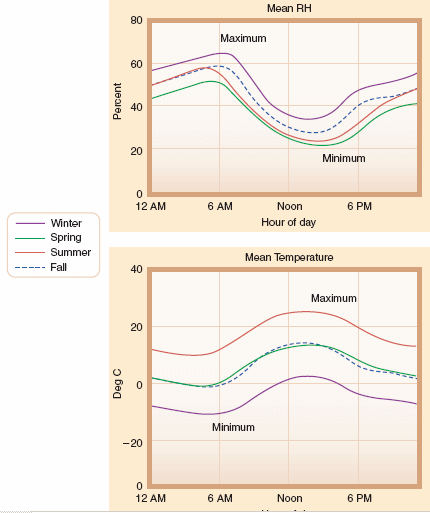
Relative Humidity
A climatology of hourly temperature and relative humidity, as observed at Bandelier National Monument,
New Mexico, from October 1988 through May 1999 is shown below.
The effect of temperature on relative humidity is illustrated in this figure. For every season of the year, relative humidity peaks around sunrise and is at its lowest in mid-afternoon. Why? The saturation vapor pressure is lowest at sunrise, when the temperature is lowest. Therefore, without a change in the actual moisture content of the air, the relative humidity will be highest at sunrise. Conversely, daytime heating raises the temperature and the saturation vapor pressure, reducing the relative humidity. This seesaw pattern of temperature and relative humidity is seen during mostly clear, relatively calm, and precipitationfree conditions, which exist most of the time in New Mexico.
In the usually dry, clear climate of New Mexico, the daily cycle of relative humidity is exactly the opposite of the temperature cycle, with a peak at sunrise and a minimum at mid-afternoon. The same daily cycle of relative humidity is observed at any location during a mostly calm, clear, dry day.
Why is this important to pilots? Notice that as the temperature decreases the relative humidity increases. Thus, on calm days if the temperaure is decreasing, the RH is increasing and this is a time for the possiblity for fog formation. So, if the dew point is close to the temperature and sunset is approaching you should look out for fog. Shortly after sunrise if a fog exists it might slightly thicken for a while, but the daytime heating should soon cause it to evaporate.
